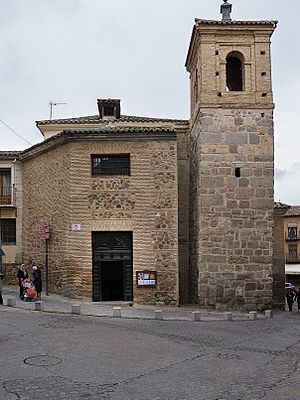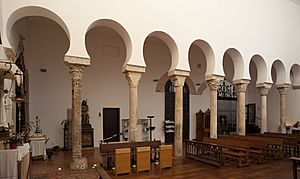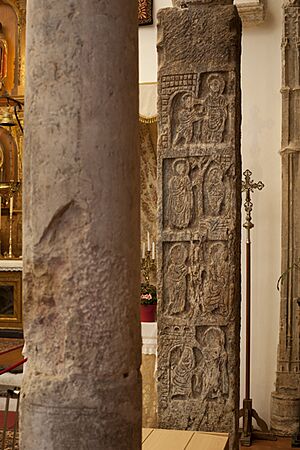Mezquita-Iglesia de El Salvador, Toledo facts for kids
The Iglesia de El Salvador is a special church in Toledo, Spain. It was finished in 1159. Even though it's not very big, this church is amazing because it was built on top of three older buildings! First, there was a Visigothic religious building. Then, a mosque from the 800s (Umayyad mosque) was built there. Later, in the 1000s, a bigger mosque (Taifa mosque) was added. Finally, the church we see today was built in the 1100s. It's like a historical sandwich!
A Look at Its History
The Iglesia de El Salvador is in the city of Toledo. It is close to other famous churches like Santo Tomé. This church is mentioned in an old Spanish book called Lazarillo de Tormes. Important people were also baptized here, including Joanna of Castile and the writer Francisco de Rojas Zorrilla.
How the Church Was Built
The church was built on top of an old mosque. Because of this, it faces southeast, towards Mecca, which is how mosques are usually oriented. Builders used parts from the even older Visigothic building that was there before. For example, you can still see a special archway inside. This archway has horseshoe arches. These arches rest on old columns called pilasters. These columns have cool carvings on them.
One of these special columns, called the Pilaster of El Salvador, shows scenes from the life of Jesus. You can see carvings of Jesus healing a blind person and bringing Lazarus back to life. There are also other carvings that remind us of Jesus as a savior. The way these carvings look shows that they were made a very long time ago.
Changes Over Time
The church tower used to be the minaret of the mosque. A minaret is a tall tower where a call to prayer is made. In 1159, the church was changed by Christians. Later, in the late 1400s, a new part was added. This was the Gothic chapel of Santa Catalina. The top part of the tower, where the bells are, was added much later in a style called Baroque.
The church is named after Saint Savior. In the 1400s, a fire damaged the church. This meant it needed a lot of repair work. A person named Álvarez de Toledo was in charge of fixing it. He also added new chapels, with the Santa Catalina chapel being a very important one.
See also
 In Spanish: Iglesia de El Salvador (Toledo) para niños
In Spanish: Iglesia de El Salvador (Toledo) para niños





